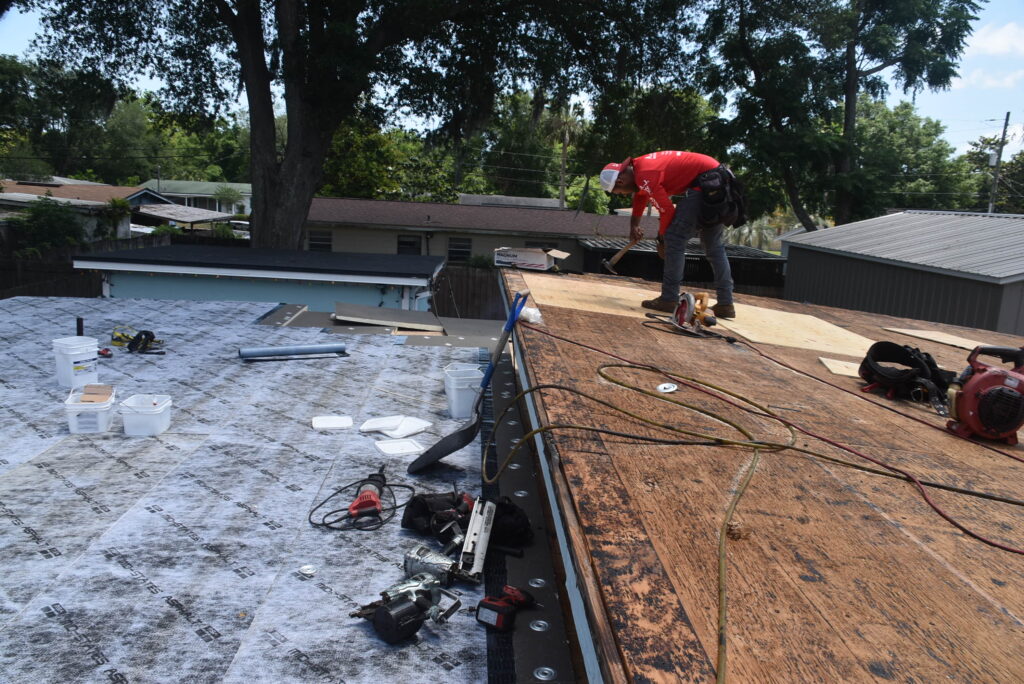Introduction
Clay County, FL, faced intense weather during Hurricane Helene, and for many homeowners, the aftermath has revealed the toll on their roofs. Asphalt shingles, while durable, are not immune to hurricane-force winds and heavy rains. If you’re a homeowner in Clay County, understanding the common types of shingle damage after a storm is crucial to maintaining the integrity of your roof and home. In this post, we’ll walk you through the most common issues with asphalt shingles following a hurricane and why it’s essential to address these problems quickly.

Common Types of Asphalt Shingle Damage After a Hurricane
- Shingle Blow-Off
One of the most noticeable signs of hurricane damage is missing shingles. When wind gusts during Hurricane Helene reached their peak, they likely loosened or ripped shingles from roofs. Missing shingles expose the underlayment and decking, making your home vulnerable to water infiltration, which can lead to leaks, mold growth, and structural damage. - Cracked and Broken Shingles
Flying debris is a major concern during hurricanes. Branches, loose objects, and other debris can collide with your roof, causing shingles to crack or break. Even small cracks can cause significant problems, as they create entry points for water to seep through and damage the layers beneath your roof. - Granule Loss
Asphalt shingles are covered with tiny granules that protect them from sun damage and weathering. Heavy rains and high winds can strip these granules away, leaving the shingles exposed to UV rays and reducing their lifespan. If you notice granules in your gutters or downspouts after a storm, this is a sign your shingles have been compromised. - Curling and Lifting Shingles
Strong winds from Hurricane Helene can cause the edges of your shingles to lift or curl. This might not seem like a major issue, but even slight lifting breaks the waterproof seal between the shingles, which can allow water to leak into your home. Over time, curled shingles can become more brittle and crack, leading to further damage. - Water Leaks
Water stains on your ceiling or walls are a sure sign that your roof’s shingles have been compromised. Leaks often indicate that water has penetrated the shingles and the underlayment, which can cause mold growth, wood rot, and damage to your home’s interior.
Why Addressing Shingle Damage Is Urgent
The longer you wait to repair your roof, the worse the damage can become. Water can infiltrate your home through damaged shingles, leading to costly repairs down the road. Additionally, leaving shingles exposed to the elements can shorten the overall lifespan of your roof and reduce the energy efficiency of your home.
Ignoring minor damage can also affect your homeowner’s insurance claim. If an adjuster sees that you delayed repairs after the storm, they may reduce the payout or deny your claim altogether. It’s crucial to document any damage immediately and schedule repairs as soon as possible to protect your home and maximize your insurance benefits.
Professional Roofing Inspections Are Key
While some signs of damage can be identified from the ground, a professional inspection is essential for uncovering hidden issues that can turn into bigger problems later. At AJ Wells Roofing and Construction, our team of experts is trained to identify and repair all types of storm-related shingle damage. We offer free inspections to help homeowners in Clay County assess their roofs after Hurricane Helene and recommend the best course of action.
Conclusion
If your roof sustained damage during Hurricane Helene, don’t wait for the problem to worsen. Addressing shingle damage promptly will save you time, money, and stress in the long run. Contact AJ Wells Roofing and Construction for a free inspection and professional roof repair. Call us today at 1-904-553-0069 to ensure your home is protected and ready for future storms.